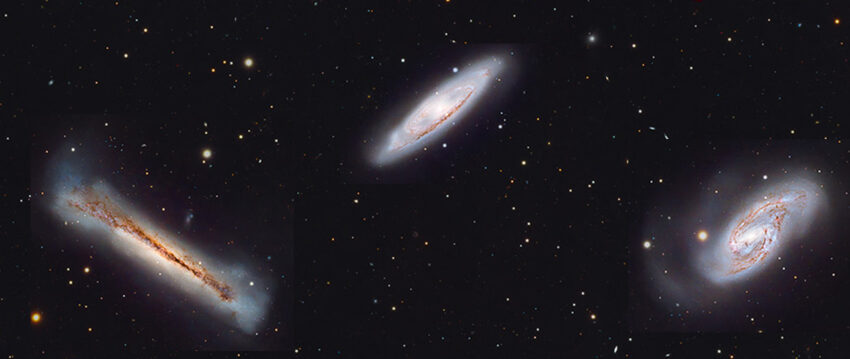The Leo Triplet, also known as the M66 Group, is one of the most picturesque galaxy groupings in the spring sky. Located in the constellation Leo, approximately 35 million light-years from Earth, it consists of three spiral galaxies: M65, M66, and NGC 3628. In my LRGB image, the differences in their structure are clearly visible — from the calm, compact form of M65, through the distorted spiral arms of M66, to the majestic edge-on shape of NGC 3628. The latter, with its dark dust lane bisecting the disk, has earned the nickname “Hamburger Galaxy.”
While these galaxies may appear serene and isolated, they are in fact gravitationally bound and interacting. Tidal forces between them, acting over millions of years, distort their spiral structures, produce long streams of matter, and lead to morphological transformations. The tidal tail extending from NGC 3628 is a clear example of such interaction, likely the remnant of a past close encounter. These forces also compress gas and dust, triggering bursts of star formation — a process known as triggered star formation. The Leo Triplet is therefore not only a stunning celestial target for astrophotography, but also an astrophysical laboratory for studying galaxy evolution and the dynamics of intergalactic interactions.
At the core of each galaxy in the Leo Triplet lies a supermassive black hole, though none of them currently exhibit the strong emission typical of Active Galactic Nuclei (AGN). Some radio and infrared observations suggest mild nuclear activity in M66, possibly due to low-level accretion. The entire group is part of a larger local structure in the Leo constellation and serves as a vivid example of how gravity sculpts the cosmos over billions of years. Capturing such a moment — even in a single frame — is a reminder that galaxies, though tens of millions of light-years away, are living systems evolving under the same physical laws that govern our own Milky Way.
Technical info:
- LRGB – 4 x 80 x 300s (total exposure time about 26 hours)
- TS APO 140/910 with field flattener and camera QHY600PH with Antlia filters
- iOptron mount CEM70EC with guiding system William Optics GuideStar 61/320 & ASI178MM
